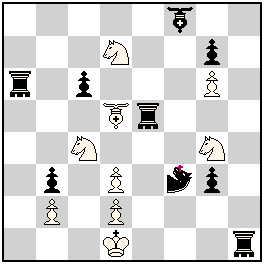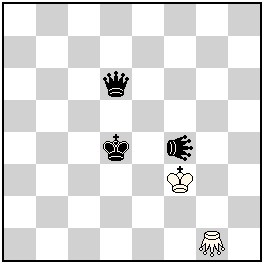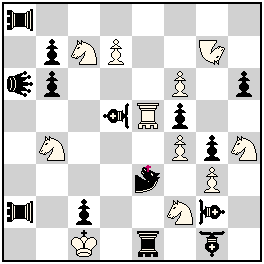|
No.230, 231 No.230.1 |
Original Problems, Julia’s Fairies – 2013 (I): January – April →Previous ; →Next ; →List 2013(I) Please send your original fairy problems to: julia@juliasfairies.com |
No.230 – #2 by Václav Kotěšovec – An interesting interpretation of Lacny theme, using Royal Zebra. (JV)
No.231 – h#7 by Václav Kotěšovec – A fine Miniature with excellent play of the Fairy duet Grasshopper-Kangaroo. (JV)
No.230.1 – #2 by Václav Kotěšovec & Nikola Predrag – An improvement of No.230 based on the comments by Nikola Predrag – January 26, 2013 and Václav Kotěšovec – January 28, 2013 (JV)
Definitions:
Grasshopper(G): Moves along Q-lines over another unit of either color to the square immediately beyond that unit. A capture may be made on arrival, but the hurdle is not affected.
Rookhopper: As Grasshopper, but moves on Rook lines only.
Bishophopper: As Grasshopper, but moves on Bishop lines only.
Zebra – (2,3) Leaper
Locust (L): moves on Q-lines but only by capturing an enemy unit, arriving on the square immediately beyond that unit, which must be vacant.
Rook-Locust (LR): Moves like Locust, but on Rook-lines only.
Bishop-Locust (LB): Moves like Locust, but on Bishop-lines only.
Nightrider(N): A Rider along a straight line on squares lying a Knight`s move away from each other.
Kangaroo (KA): Moves along Queen-lines like a Grasshopper, but over 2 hurdles (which may or may not stand on adjacent squares) to the square immediately beyond the second hurdle. A capture may be made on arrival, but the hurdles are not affected.
Anti-Andernach:A piece (excluding King) changes its color after any non-capturing move. After capture, the piece retains its color. Rooks on a1, h1, a8 and h8 can be used for castling, provided the usual other rules for that move are satisfied. After castling, Rooks do not change color, If White makes a non-capturing move with neutral or halfneutral piece, that piece becomes black and vice versa.
PWC: When a capture is made, the captured unit (except a King) is replaced on the square the capturing unit just leaves. A Pawn is immovable on its 1st rank.
|
No.230 Václav Kotěšovec
Czech Republic
original-19.01.2013
 #2 (9+9)
b) Anti-Andernach Royal Zebra f3 Rookhoppers: a6, e5, h1 Bishophoppers: d5, f8 Solutions: (click to show/hide)
|
No.231 Václav Kotěšovec
Czech Republic
original-19.01.2013
 h#7 3 solutions (2+3)
PWC Grasshopper g1 Kangaroo f4 Solutions: (click to show/hide)
|
|
No.230.1 Václav Kotěšovec & Nikola Predrag
Czech Republic / Croatia
Version of No.230, 28.01.2013
 #2 (11+14)
b) Anti-Andernach Royal Zebra e3 Rookhoppers: e1,e5 Bishophopper g1 Bishop-Locust d5 Rook-Locusts: a2, a8 Bishop-Lion g2 Nightrider g7 Kangaroo a6 Solutions: (click to show/hide)
|



N.230. This composer has done many beautiful problems using the Hybrid. Once you understand what happens here you admire the simple but intriguing concept of selfblock moves becoming guarding moves ! Great !
No.230
I’ve seen only few fairy direct mates and to me, such change of effects on the same squares arranged in a cycle looks incredible. Flaws in aesthetic and economy, caused by a construction of the keys, still do not spoil the purity of the idea.
Could the flaws in economy and aestethic be justified in a sixfold cycle?
Pieces
Black royal Ze3
White Sc7 Pd7 Ng7 Pf6 RHe5 Sb4 Pf4 Sh4
Pg3 Sf2 Kc1
Black LRa8 Pb7 KAa6 Pb6 Ph6 LBd5 Pf5
Pg4 LRa2 Pc2 BLg2 RHe1 BHg1
Twin Condition AntiAndernachChess
a) 1.RHe7-e2! Zz
1…RHb1 (a) 2.Kd2# (A)
1…b5 (b) 2.Scxd5# (B)
1…BLc6 (c) 2.Sbxd5# (C)
1…RHh1 (d) 2.Sxg4# (D)
1…h5 (e) 2.Nxf5 (E)
1…KAg6 (f) 2.Sxf5# (F)
b) 1.d8=bBH! Zz
1…RHb1=wRH (a) 2.Scxd5# (B)
1…b5=wP (b) 2.Sbxd5# (C)
1…BLc6=wBL (c) 2.Sxg4# (D)
1…RHh1=wRH (d) 2.Nxf5# (E)
1…h5=wP (e) 2.Sxf5# (F)
1…KAg6=wKA (f) 2.Kd2# A
Few tries in b)
1.d7-d8=bKA? 1…KAd8-a5=wKA!
1.d7-d8=bBL? 1…BLd8*h4!
1.d7-d8=bRH? 1…RHd8-d4=wRH!
1.d7-d8=bLB? 1…LBd8*f6-g5!
Correction of the typo a) 1. RHe2! (RHe5-e2)
Fairy pieces: LRa8, LBd5, BHg1, RHe1, BLg2, LRa2, RHe5, KAa6, Ng7, royal=Ze3
LR, LB ? Locust rook, Locust bishop? Hope it will be published as a original.
6-fold cycle is certainly better, also keymove in b) is good, it’s only pity that technical pieces (rook-locust and bishop-locust) are necessary. But probably is no other chance for guarding of c2 (squares b1 and b2 must be free and any possible move of such piece would be refutation). Rook-locust a8 is not necessary in b), but in a) eliminate many cooks after promotion of pawn d7 and can be place on b8, f8 or h8. I not found better construction of this version. Summary: I seem version by Nikola Predrag as improvement of my problem and propose publish it as joint problem 230a.
(Dear Julia, I will send you new diagram and WinChloe files by e-mail immediately)